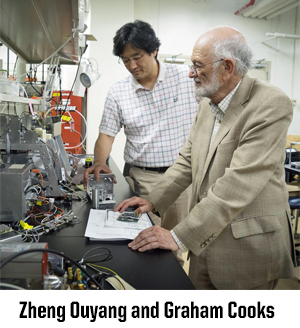Alumnus Zheng Ouyang returns to campus to talk about his team’s mass spectrometry breakthrough
2024-02-15
Writer(s): Steve Scherer

Research by a former Purdue Chemistry graduate student, Zheng Ouyang, is being called “A leap forward in drug discovery,” “using workhorse of chemistry.” His team’s work was recently published in Science.
Dr. Ouyang completed his Ph.D. in 2002, working with Professor R. Graham Cooks. He subsequently took a faculty position in biomedical engineering at Purdue, leaving in 2016 for his current position at Tsinghua University in Beijing.
Dr. Ouyang is visiting Purdue on Monday, February 19, and will give a talk about how his team has successfully demonstrated the use of mass spectrometry to separate chiral molecules. The lecture begins at 3:30 pm in WTHR 104. His talk is titled "Enantioselective mass spectrometry and other advances.”
Dr. Cooks commented on the breakthrough and its impact:
The molecules of life are chiral, they come in two non-superimposable forms which are otherwise identical. Why do living organisms use pure chiral forms not mixtures? The reason is the same as that which applied to the construction of the biblical Tower of Babel, where a single language was needed for clear communication. Just so in molecular communication, a single chiral form, for example of amino acids that make up proteins, is essential.
Measuring chirality is a key aspect of drug development and quality control in the pharmaceutical industry. Why this is so, is evident in the disastrous birth defects that occurred in the 1960s from the use of the wrong chiral form of the sleep medicine thalidomide. Chirality is measured by chemical interactions with a chiral molecule, surface or, indeed, as shown by Ouyang and his group, with a chiral electric field. This group at Tsinghua University in Beijing, trapped ions in a mass spectrometer and subjected them to a chiral rotating electric field. The interactions of the molecules with the field depend on their chirality and in this way the chiral forms are separated as seen in the mass spectra of the ions.